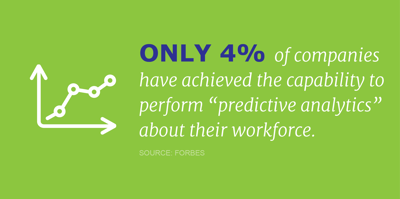The Benefits Of Using Talent Analytics In The Candidate Experience
August 11, 2016For experienced talent acquisition professionals, candidate experience may seem like a topic that has been fully analyzed from every angle. It has been well-established what a positive and negative experience look like and the outcomes of both. Its importance is widely acknowledged and the best recruiters will always strive to give candidates a top-notch interview experience. So, the question remains, is our work here done?
The answer is "no." As HR technology tools and economic and workforce changes continue to develop and morph, so must the talent acquisition industry’s approach to candidate experience.
On a Human Capital Institute webinar titled “Predictive Analytics: Optimize Your Candidate Experience,” WilsonHCG's John Blowers and iCIMS' Jim Delgaldo investigated three important aspects of a candidate's experience in today's recruitment climate: predictive analytics, mobile optimization and globalization.
Benefits of predictive analytics
In general terms, predictive analytics in HR allows organizations to make better-informed decisions on hiring and improve their processes based on predictive statistics or talent analytics. This provides talent acquisition professionals the HR technology tools they need to improve their response time, analyze traits of top performers and apply that knowledge to improve the hiring process and minimize risk.
Since this data can predict trends in applicant flow, recruiters can be better prepared to respond more quickly and effectively to a high volume of candidates. Whether that means adding support or carving out more time for contacting candidates, this is crucial in an environment where 90 percent of candidates expect automated frequent updates and 67 percent expect a personal phone call after applying for a position.
Leveraging talent analytics to improve candidate experience and minimize the risk of losing employees down the line is also a benefit. And, don't forget, candidates can bring more to a company than just being a "good hire." They can provide candidate and client referrals, which can bring in new revenue opportunities. While HR data and talent analytics shouldn’t be the only factor taken into consideration, they can provide compelling insights to maximize opportunity and minimize risk.

The Mobile Candidate Experience
There is a major disconnect between the one-third of companies that do not have a mobile-optimized website and the 65 percent of candidates who will “rarely return” to a website if it is not optimized for their mobile devices. As Blowers and Delgaldo discussed throughout the webinar, best practices include ensuring applications are accessible from any device, allowing candidates to apply via social media profiles (such as LinkedIn, Google+ and Facebook), and confirm the application will not take longer than 15 minutes to complete. Unsure whether your application process fits this description? Stop what you’re doing and “be the candidate” — go through your organization's application process from your mobile device and identify the flaws.
These simple practices address the needs of the candidates to increase throughput and improve the quality of candidates for the recruiter. Just by choosing an applicant tracking system that automatically parses a job seeker’s uploaded resume to reduce data entry will save time and work to retain the 65 percent of job seekers who search for jobs via mobile devices then leave a website if it isn’t mobile optimized.
Globalize and localize
Through the ability to track candidate behavior on a career site, organizations can determine how candidates are getting there and what they’re doing once they are there. Then the talent analytics data can be viewed on a global scale or pivoted based on geographic region to identify what sources of hire are responsible for the most candidates for in certain areas.
This may be used to integrate global and regional strategies where organizations present a clearly defined global culture but the employee value proposition may be unique to a local area. During the webinar, this tactic was referred to as “glocalization” and is a major concept in improving a candidate's experience moving forward. For example, a candidate may be attracted to a large, well-established company but doesn’t want to feel like one cog in a giant machine. Glocalization strategy would be able to capture key aspects of local company culture such as community volunteerism or engagement activities to personalize their experience.
In the Q&A portion of the webinar, the first question asked was, “What is the best way to start to reevaluate the experience your candidates have?” The answer is to start by being the candidate. Visit your own career site through a candidate portal, apply to your own jobs and try to get a sense of your culture and employer brand from the outside. Is the career site easy to navigate? Is the application process simple? Is the company message clear? These are the questions that will lead you down the path to meeting and exceeding today’s candidate expectations.
About WilsonHCG
WilsonHCG is an award-winning, global leader in total talent solutions. Operating as a strategic partner, it helps some of the world’s most admired brands build comprehensive talent functions. With a global presence spanning more than 65 countries and six continents, WilsonHCG provides a full suite of configurable talent services including recruitment process outsourcing (RPO), executive search, contingent workforce solutions, talent consulting and talent intelligence.


![[AT A GLANCE] The Candidate Experience Can Have A Major Impact On Your Company's Image And Reputation. Learn More In Five Minutes Or Less.](https://no-cache.hubspot.com/cta/default/441864/e6c71050-0b8e-40e1-a19c-5724ae106082.png)
